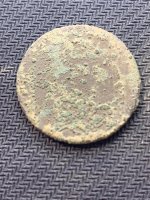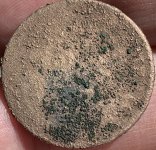bobleyland
Greenie
Hunted an unpaved Connecticut farm road connecting two fields yesterday and got a 65 hit on my White's Blue & Gray (5900 DI Pro). Dug an apparently heavily corroded copper coin, 1 1/16" diameter. (Also dug a 1986 quarter w brick red patina, nearby) Much thinner than a large cent. Light sanding of tiny portion of the edge revealed copper. Soaked overnight in olive oil. Cleaned w soapy water. Soaked overnight in 2% hydrogen peroxide. No identifiable markings.
Could the surface have corroded this badly, or could there be a rock-hard coating that can be removed? Hoping for my first Colonial. Thanks.
Could the surface have corroded this badly, or could there be a rock-hard coating that can be removed? Hoping for my first Colonial. Thanks.
Attachments
Upvote
11







 Let us know if you can coax an ID from it.
Let us know if you can coax an ID from it.



